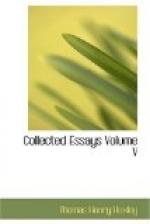It is remarkable, in looking back, to notice to what an extent this and other survivals of scholastic realism arrested or, at any rate, impeded the application of sound scientific principles to the investigation of biological phenomena. When I was beginning to think about these matters, the scientific world was occasionally agitated by discussions respecting the nature of the “species” and “genera” of Naturalists, of a different order from the disputes of a later time. I think most were agreed that a “species” was something which existed objectively, somehow or other, and had been created by a Divine fiat. As to the objective reality of genera, there was a good deal of difference of opinion. On the other hand, there were a few who could see no objective reality in anything but individuals, and looked upon both species and genera as hypostatised universals. As for myself, I seem to have unconsciously emulated William of Occam, inasmuch as almost the first public discourse I ever ventured upon, dealt with “Animal Individuality,” and its tendency was to fight the Nominalist battle even in that quarter.
Realism appeared in still stranger forms at the time to which I refer. The community of plan which is observable in each great group of animals was hypostatised into a Platonic idea with the appropriate name of “archetype,” and we were told, as a disciple of Philo-Judaeus might have told us, that this realistic figment was “the archetypal light” by which Nature has been guided amidst the “wreck of worlds.” So, again, another naturalist, who had no less earned a well-deserved reputation by his contributions to positive knowledge, put forward a theory of the production of living things which, as nearly as the increase of knowledge allowed, was a reproduction of the doctrine inculcated by the Jewish Cabbala.
Annexing the archetype notion, and carrying it to its full logical consequence, the author of this theory conceived that the species of animals and plants were so many incarnations of the thoughts of God—material representations of Divine ideas—during the particular period of the world’s history at which they existed. But, under the influence of the embryological and palaeontological discoveries of modern times, which had already lent some scientific support to the revived ancient theories of cosmical evolution or emanation, the ingenious author of this speculation, while denying and repudiating the ordinary theory of evolution by successive modification of individuals, maintained and endeavoured to prove the occurrence of a progressive modification in the divine ideas of successive epochs.




